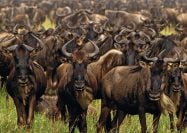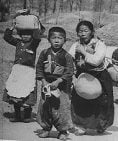 If I lived in Africa, I would get annoyed having to push and squeeze through the thousands of wildebeest cluttering up the place and getting in everyone’s way. But I am up the hill from Hong Kong’s Central, and the herds are mainly of Korean tourists.
If I lived in Africa, I would get annoyed having to push and squeeze through the thousands of wildebeest cluttering up the place and getting in everyone’s way. But I am up the hill from Hong Kong’s Central, and the herds are mainly of Korean tourists.
The younger ones stick together in pairs – typically two females. The one with page-boy-style ginger hair and shocking cherry red lipstick carries the guide book; the other looks more normal and wields the selfie stick. Sometimes, like when they mistake the Mid-Levels Escalator for a relaxing ride at Disneyland, residents have to give them a firm but polite shove to get them to move aside.
 The older ones move in packs of one or two dozen, mixed male and female. They wear baseball caps, and their wizened faces have a slight but unmistakable look of alarm. For some reason their handlers require them to assemble outside Marks & Spencers. Their generation endured terrible hardship and trauma back in the 1950s, so I personally try to keep physical force to a minimum when they get in the way – a gentle elbow at the most.
The older ones move in packs of one or two dozen, mixed male and female. They wear baseball caps, and their wizened faces have a slight but unmistakable look of alarm. For some reason their handlers require them to assemble outside Marks & Spencers. Their generation endured terrible hardship and trauma back in the 1950s, so I personally try to keep physical force to a minimum when they get in the way – a gentle elbow at the most.
The daily presence of these hordes in my neighbourhood is something of a mystery. The  Korean culture of fanatical and unquestioning obedience must play a part: the guide book instructs them ‘go to the overrated egg-tart shop’, so go they must. In truth, we don’t care why they come here. We just wish they wouldn’t. Nothing personal – there’s just not enough space.
Korean culture of fanatical and unquestioning obedience must play a part: the guide book instructs them ‘go to the overrated egg-tart shop’, so go they must. In truth, we don’t care why they come here. We just wish they wouldn’t. Nothing personal – there’s just not enough space.
At least, that’s what we thought. However, today’s South China Morning Post uses what it calls a ‘formula devised by statistician Nate Silver’ to calculate whether Hong Kong is really overcrowded with tourists. Essentially, it’s the annual number of visitors divided by average length of stay as a percentage of the population. There are two key findings:
- The smaller a place is, the more crowded it gets.
- The Koreans, Mainlanders and others who crowd Hong Kong’s sidewalks are not there at all, but merely figments of our imagination.
Lawmaker Michael Tien ‘hails’ the data as proof that Hong Kong can easily cram more tourists in. The SCMP mentions in passing that the research results do not reflect the possible clustering of tourists by districts or season, but the general impression is that this is a minor and barely relevant point. The extra visitors would not, presumably, all hang out in particular crowded spots – like the cash registers in the G2000 clothing stores of which Tien is chairman – but be scattered around the city so sparsely that you would not even realize they are there, like the thousands of Koreans who it seems are not, after all, pouring into the neighbourhood every day.

The data proves nothing regarding over-crowding unless it takes into account crowd density at specific locations at certain times. This bad is science.
In most of TST (and lots of Mongkok and Causeway Bay), it seems the predominant language is Putonghua, particularly on weekends. But I guess those aren’t tourists–just locals practicing their language chops as they resign themselves to ever more “integration.”
As for Macau, that is a pretty low bar for comparison seeing as how the entire economy is now built on gaming and hospitality (and money laundering)… Surely Las Vegas has a higher proportion of tourists than New York.
Lies, damn lies and statistics.
Well, there is a notable absence of tourists from Hong Kong’s more obscure and run-down neighbourhoods like Tsz Wan Shan (known for gas explosions) and Ma Tau Kok (known for collapsing buildings). Of course, there is also a notable absence of anyone else, since neither tourists nor locals have much interest in hanging around auto repair shops, tutorial centres and plumbing supplies wholesalers. The obvious solution, of course, is to move half of all the G2000s, Marks & Spencers, and overrated egg tart shops into such areas. Duh.
Once again I detect signs of strain. You need to buy a yellow Porsche or even better a Dahon folding bike. The look of terror on most tourist’s faces as you hurtle towards them amply replays the outlay.
Interesting they chose 2012 as a comparison year. When HK tourists were at 48 million and Singapore at 15.4 million a year. By 2014 HK had increased to 60 million, while Singapore decreased to 15 million. Even in 2012 it is hard to understand how Singapore was apparently more crowded given an average stay of 3.5 days compared to 4 in HK and given HK’s population is about 33% more than SG. Seems HK was 2.5 * more crowded to me based on HK and SG government statistics.
Vatican – given ppl generally don’t eat there or stay there, perhaps Rome would be a better comparator? Of course the broader flaw is the tourist as % of population may be less relevant than the tourists per unit area.